
Mar 31, 2001, The B. H. Manuscript/Collectible/Philatelic Sale, Sale 9

Lot 445
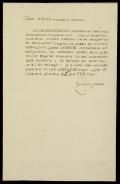

Catherine the Great
(1726-1796). Empress of Russia. After deposing her estranged husband,
Catherine named herself empress. Though she managed to extend the empire
and "westernize" the nation, her reign was marked by misery among peasants.
Document Signed ("Yekaterina"). As Empress. In Cyrillic. One
page with integral blanks, oblong quarto, Moscow, February 26, 1763. In
black ink. Docketed on integral blank. Gilt detail to paper edges. With one
light horizontal fold at center, a few pinholes at upper right, rough and
slightly soiled edges. Overall, in very good to fine
condition.
Shortly after her coronation in September of 1762,
Catherine signs this imperial decree addressed to "Our Court Office"
ordering the office to give the old and tattered livery to liveried
servants in lieu of a reward. Further, the donation is to be considered as
an expenditure.
Estimated Value $1,000-1,200.
Lot 446


Diana, Princess of
Wales (1961-1997). Diana Frances Spencer, the daughter of Lord and Lady
Althorp, joined the Royal Family when she married Prince Charles in July
1981. Their televised fairy tale wedding captured the hearts of all those
in England, as well as the millions of viewers throughout the world. While
carrying out her royal duties she worked tirelessly to help the
disadvantaged and ill, giving special attention to those suffering from
AIDS. But after eleven years of marriage and intense speculation, a
tell-all book revealed the truth of Diana and Charles' distant and
passionless relationship. Shortly thereafter, the couple became officially
separated and the marriage was dissolved in August of 1996. Tragically,
just one year later, Diana was involved in a fateful car crash that not
only took her life but left the world devastated.
Signatures
("Diana" and "Charles"). One page, octavo, n.p.,
"1989". In black ink. A 3 x 4" color photograph of the Princess and
her husband has been affixed to the signed card, and framed in an official
frame featuring the three plumed emblem of the Princess of Wales for an
overall size of 5½ x 7½". Signature is a bit faded. Otherwise
in very good condition.
In 1989, Diana pens her autograph below a
picture of the Royal couple and signs with her husband, despite the fact
that by this point, the two were living separate lives.
Estimated Value
$1,000-1,500.
Lot 447
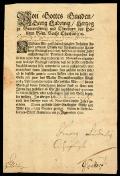

George I
(1660-1727). Elector of Hanover and first Hanoverian king of Great
Britain. George became king as a condition of the Act of Settlement
requiring a Protestant heir to the throne.
Document Signed
("Georg Ludwig"). In German. Partially printed, accomplished in
manuscript. As Elector. One page, quarto, Hanover, December 31, 1701. In
black ink. With two horizontal folds, trimmed, foxing around edges, with a
semi-circular stain at center left edge likely from a seal no longer
present. In good condition overall.
At the request of Duchy of
Calenberg, George signs this document, allowing the year's tithe paid in
corn (at that time, a mixture of wheat, rye, oats), cash, or any
combination thereof: "We so order you herewith most graciously to inform
said subjects ... to deliver their assigned amount in produce or in money
at the above rate and measurement".
Interestingly, this document
was signed the very year that the act of Settlement was enacted, thereby
paving the way for George's succession to Queen Anne.
Estimated Value
$750-900.
Lot 448


Henry VII
(1457-1509). King of England. After becoming King, Henry married
Elizabeth of York, thereby uniting the houses of York and Landcaster,
becoming the first Tudor King. An active and able administrator, Henry
quelled two rebellions, and often encouraged royal marriages to strengthen
the monarchy and maintain peace. He also began the move towards royal
absolutism, or the belief in the divine right of kings.
Manuscript
Document. One page, quarto, Greenwich, February 14, n.y. Being a
testemonial. To Sir Edward Poynings, Comptroller of the Household and Lord
Warden of the Cinque Ports. In brown ink. Stamped with Henry VII's black
woodcut signature. Obviously clipped from a larger document, rough right
edge, with two small losses, folds verso, and toning. Partially mounted.
Stamped signature is clear and bold.
Here the King cites a formal
complaint, made by two gentlemen of Holland, in a testimony under the
town's seal. The pair claim that seven lasts and eight barrels of herring
were taken from them at sea by the Mayor of Faversham. The Comptroller of
the Household is consequently commanded to request immediate restitution of
the fish, allowing the unfortunate victims to sell it, thereby earning
their intended profits. In addition, the Mayor is required to face the King
regarding this matter.
Estimated Value $1,500-2,000.
Lot 449
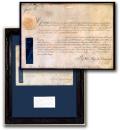

King Geoge III and
William Pitt (1738-1820). King of England whose reign spanned from
1760-1820, despite multiple bouts with mental illness.
Document
Signed ("George" and "Wm Pitt"). Partially printed,
accomplished in manuscript. As King. One page, folio, St. James, London,
July 31, 1761. Being a military appointment. On parchment. In brown ink.
With original paper seal and blind stamp seal at left edge. Attractively
matted and framed to an overall size of 19 x 23". With three horizontal
folds, a 2" vertical crease at lower left, and light soiling.
When
King George III inherited the throne in 1760 he opposed many of the
existing government ministers, however the value of William Pitt's military
leadership could not be overlooked. Though King George's early reign was
marked by constant struggles with his ministers, Pitt managed to survive
the turmoil. Here the pair sign this appointment thereby naming one Thomas
Elbridge as an Ensign.
Estimated Value $350-450.
Lot 450
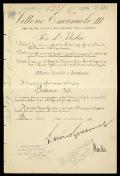

King Vittorio Emmanuel
III and Mussolini. Document Signed ("Vittorio Emmanuel" and
"Mussolini"). Vittorio Emmanuel signs as King of Italy while
Mussolini signs as head of the Italian government. In Italian. One page,
folio, Rome, March 11, 1926. Docketed recto and verso. In black ink. A
horizontal crease at center and diagonal crease across lower portion.
Evenly spaced nicks along the left margin, suggesting the document may have
been bound at some point. In very good condition.
This document, a
dishonorable discharge, dismisses Lieutenant Italo Predari for "grave
offenses" that violated an Italian law dating to 1912. Unfortunately, the
document does not specify the exact offenses.
Estimated Value $300-450.
Lot 451
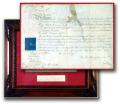

King William IV
(1765-1837). King of Great Britain and Ireland, succeeding his brother
George IV as king. He was also responsible for the first Parliamentary
reforms since 1430.
Document Signed ("William R"). As King.
Partially printed, accomplished in manuscript. One page, folio, n.p.,
December 28, 1830. Being a military commission. On vellum. In black ink.
With original blind stamped seal at left. Countersigned by Lord Melborne.
Elaborately matted and framed to an overall size of 24 x 20". With three
vertical and two horizontal folds. Soiling at top center does not affect
the signature. In good condition overall.
In the first year of his
reign, William IV appoints one Henry Robert Addison to be adjutant of the
2nd Queen's Regiment of Guards.
Estimated Value $250-350.
Lot 452
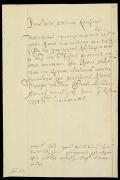

Petrovna, Elizabeth
(1709-1762). Empress of Russia. The daughter of Peter the Great and
Catherine I, Elizabeth gained the throne by using her popularity to
overthrow the government of Ivan VI and his mother. Upon gaining power, she
abolished the Cabinet council system of government and reinstated the
Senate created by her father. Her reign was marked by an increasing control
of the aristocracy over the government and peasantry. Her cultural
accomplishments include the foundation of the Academy of Fine Arts in St.
Petersburg, the University of Moscow, and the Hermitage.
Document
Signed ("Elizavet"). In Russian. One page, oblong quarto, St.
Petersburg, May 5, 1737. In black ink. To the Patrimonial Chancery. With
one soft horizontal fold at center, toning around edges. In very good to
fine condition overall.
The town of Tsarskoe Selo was considered the
royal village since 1725. A small town just outside of St. Petersburg, it
was a country retreat used by Russian royalty as a summer residence and
soon became a cultural treasure with its spacious parks, Baroque palaces
and monuments. In this imperial decree, Elizabeth makes arrangements
regarding the village, commanding the Patrimonial Chancery to: "Inquire
of our reserve storage facility whether there will be a sufficient number
of chetverts of oats left over after consumption up to the coming month of
October of this year and to issue the excess oats to the keeping of the
Tsarskoe Selo peasants for seed..."
Estimated Value $750-1,000.
Lot 453


[Victoria]. Two
Autograph Letters Signed. 1. Autograph Letter Signed by Edward Duke of Kent
("Edward"). Two pages, recto and verso, quarto, Kensington Palace,
London, December 9, 1811. Fascinating, lengthy letter with Napoleonic
War content. 2. Victoria Mary-Louisa, Duchess of Kent. Autograph Letter
Signed ("Victoria"). Two pages, recto and verso, octavo, n.p.,
November, 1853. Features a blind embossed Royal seal. Being a request from
Victoria to a "Lady Fanny" that she write to a Madame Bullande regarding
arrangements for a governess to accompany Victoria's grand-daughter
(probably the Princess Victoria, "Vicky") during her stay. In fine
condition.
A very nice lot featuring both of Queen Victoria's
parents.
Estimated Value $400-600.
Lot 454
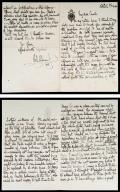

Wilhelm II
(1859-1941). German Kaiser and Prussian King from 1888 until the end of
World War I. Deeply concerned with military matters, Wilhelm supported the
expansion of the German Navy under Tirpitz and sought to increase Germany's
international scope in spite of British and French influence.
Autograph Letter Signed ("William I R"). As Kaiser of
Germany. In English.Two pages, recto and verso, quarto, Schlitz, June 6,
1904. On stationery bearing the royal emblem. To King Edward VII of
England. In black ink. Accompanied by transmittal envelope, complete
with intact wax seal. Mailing folds, some ink fading, image from seal
lightly transferred to bottom half of first sheet. Very good to fine
condition.
This important letter contains outstanding content,
illustrating the complex relationship between England and Germany as the
world gradually slid into World War I. The German Kaiser, nephew to the
King of England, Rear-Admiral in the British Navy and Field Marshal in the
British Army, was granted full access to the British fortifications at
Gibraltar -- in spite of the German Navy's aggressive expansion and ongoing
tensions in North Africa. This access, typical of the way family
connections between Victoria's offspring overcame normal considerations,
resulted in the letter offered here. In his usual fashion, Wilhelm's letter
is a mix of family feeling, boasts and good advice. In full:
"My
dear Uncle, On my return home I think it my duty once more to thank you
warmly for the reception accorded me at Malta and Gibraltar. As both
governors expressly mentioned to me that they had your orders to receive me
like yourself, you may be sure that I feel deeply touched by this kind
measure of courtesy in which you so well excell. It gave me great pleasure
to be able to associate with so many of your officers in both your
services, and to become acquainted with the men foremost on the lists of
their country, whose names like dear Sir W. Whites, have already called of
forth admiration of the brothers in arms of the world and especially in our
army. During my walk up the cliff at Gibraltar I was struck that there is
still lots of room left where to place heavy, far carrying guns. If I may
be allowed to mention the fact, I think that the Rock ought to carry a
larger number of heavy ordnance; the 9.5 gun is -- especially at long
ranges -- not powerful enough to cope with the heaviest guns carried by the
modern battleships, they ought -- according to my humble notions -- to be
replaced by 12 inch Guns. Of these there are a certain number lying at the
dock in Malta belonging to the Fleet who would be most happy to sell them
to the Army for use on the shore, as they can not be employed on board. The
maneuvers which have been going on between the Channel fleet and the Rock,
have shown, that the 6 ships of this Fleet are amply sufficient to keep the
whole of the Rocks heavy ordnance fully occupied if attacked from one
side only; but should an Enemy dispose two squadrons on both
sides, and begin a simultaneous attack, the Rock
would, without help by a friendly Fleet, be unable to
withstand a bombardment like this in the long run. I must beg your pardon,
if I intrude upon your kindness & seem to mix into matters that do not
concern me, but as I have the honor of being a British Field Marshall, I
though I might be allowed to attract your attention to these facts. The
more so as I have always taken a great interest in fortifications & their
defence. I fancy, that should you hear Gen. Slade's opinions about this
question, he will bear me out. I was very glad to see dear old DC Warre
from Eton at Malta, a man for whom I have the greatest admiration as
educator & former of boys characters. With my best love to Aunty & cousins,
& with renewed thanks believe me Ever Your Affectionate Nephew"
While this is not the place to discuss all of the causes of the
Great War, the intimate relationship between the rulers of Germany and
Great Britain, in concert with the Kaiser's lifelong belief that dynastic
kinship would transcend the conflicts of rival governments, absolutely
affected royal perception (in both countries) of the ultimate outcome of
political maneuvering and military buildups in the decade leading up to
World War I.
Estimated Value $4,000-6,000.